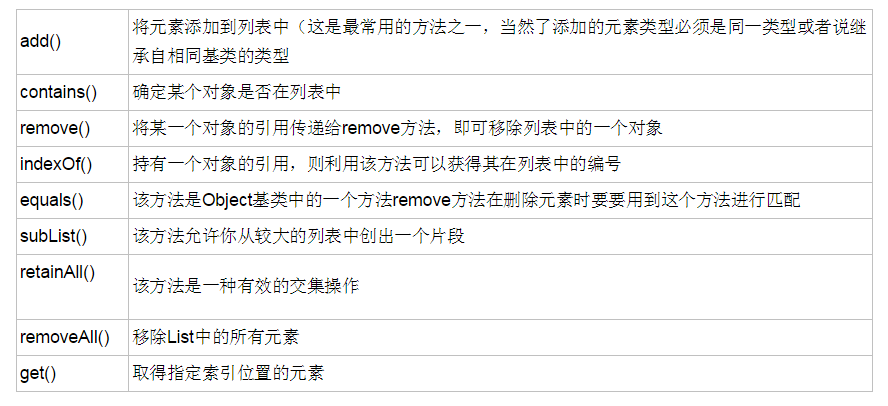1、List
ArrayList,它长于随机访问元素,但是在List的中间插入和移除元素时较慢。
LinkedList,它通过代价较低的在List中间进行的插入和删除操作,提供了优化的顺序访问。LinkedList在随机访问方面相对比较慢。
(1)ArrayList
方法有:
构造示例:
List l3 = new ArrayList();
List<Integer> l1 = new ArrayList<Integer>();
List<MyClass> l2 = new ArrayList<MyClass>();
// 方法应用例子:-------------------------------------------------
List<String> ls = new ArrayList<String>();
//增加元素
ls.add("s1");ls.add("s2"); 。。。
ls.add(3, new String("s8")); // 将新元素放在下标为3处
ls.addAll(2, ls2); 将表ls2添加到ls中下标为2的开始位置
ls.addAll(ls2); 直接加到末尾
// 删除元素
ls.remove(s6);
copy.remove(2); // Remove by index
ls.removeAll(ls2); 将ls2中的所有从ls中移去
// 清空表
ls.clear();
// 修改元素
ls.set(1, new String("s9")); 修改下标为1的元素
// 获取某位置元素
String s3 = ls.get(2); //下标为2的元素
// 求某元素的下标,如果不在线性表中返回-1
ls.indexOf(s3)
// 求子线性表
List<String> sub = ls.subList(1, 4); 下标从1到3的子表
// 是否为空
ls.isEmpty()
// 是否包含某对象
String s6 = new String("s6");
System.out.println(ls.contains(s6));
System.out.println(ls.containsAll(sub)); 判断sub是否是ls的子表,此处不考虑顺序只考虑是否包含元素
// 将表赋值给另外一个表
List<String> copy = new ArrayList<String>(ls);
// 数组转化为List
ls = Arrays.asList("as", "ad");
或int[] a_int = { 1, 2, 3, 4 };
List a_int_List = Arrays.asList(a_int);
// List转化为数组
Object[] o = ls.toArray();
String[] str = ls.toArray(new String[0]);
// 表仅保留交集的元素
ls1.retainAll(ls2); ls1仅保留ls1与ls2的交集元素
// 表的排序
Collections.sort(ls);
// 表里元素之间顺序随机化,即打乱
Collections.shuffle(ls);
或 Random rand = new Random(47);
Collections.shuffle(sub, rand);(2)LinkedList
LinkedList也实现了基本的List接口,但是在某些方面它要比ArrayList要高效一些,如插入和移除操作,但是在随机访问方面要逊色一些。
LinkedList还有一个重要的作用是用来实现栈、队列以及双端队列等数据结构中的一些基本结构
方法:
因为LinkedList也实现了List接口,当然上面ArrayList中的方法也都包含,除此之外它还包含如下方法
List l = new LinkedList();
List<String> ls = new LinkedList<String>();
其他代码略栈和队列
Stack在新版本的Java中是不推荐使用,有了LinkedList,我们完全可以自己很快的写一个,因为说到底栈无非就是操作受限的链表。
import java.util.LinkedList;
public class Stack<T> {
private LinkedList<T> storage = new LinkedList<T>();
public void push(T v) {
storage.addFirst(v);
}
public T peek() {
return storage.getFirst();
}
public T pop() {
return storage.removeFirst();
}
public boolean empty() {
return storage.isEmpty();
}
public String toString() {
return storage.toString();
}
} 队列:
在java5中新增加了java.util.Queue接口
LinkedList类实现了Queue接口,因此我们可以把LinkedList当成Queue来用
import java.util.LinkedList;
import java.util.Queue;
public class QueueTest {
public static void main(String[] args) {
Queue<String> queue = new LinkedList<String>();
//添加元素
queue.offer("a");
queue.offer("b");
// 遍历队列
for(String q : queue){
System.out.println(q);
}
//队列中删除并返回第一个元素
System.out.println("poll="+queue.poll());
// 下面两个方法均是访问第一个元素
System.out.println("element="+queue.element()+queue.peek());
}
}2、Set
Set不保存重复元素。
Set实现:HashSet和TreeSet,而在HashSet的基础上还实现了一个LinkedHashSet。
- HashSet:拥有最快的查询速度,存入HashSet的元素必须定义hashCode()方法
- TreeSet:保持元素处于排序状态,底层为树结构。使用它可以从Set中提取有序的序列。元素必须实现Comparable接口
- LinkedHashSet:以插入顺序保持元素,用迭代器进行遍历时会按照插入时的顺序显示,但也必须定义hashCode()方法
Set具有与Collection完全一样的接口,因此没有任何额外的功能,
而ArrayList和LinkedList具有额外的功能。
import java.util.*;
// 下面的SetType,HashType,TreeType都是自己定义的类
class SetType {
int i;
public SetType(int n) {
i = n;
}
public boolean equals(Object o) {
return o instanceof SetType && (i == ((SetType) o).i);
}
public String toString() {
return Integer.toString(i);
}
}
class HashType extends SetType {
public HashType(int n) {
super(n);
}
public int hashCode() {
return i;
}
}
class TreeType extends SetType implements Comparable<TreeType> {
public TreeType(int n) {
super(n);
}
public int compareTo(TreeType arg) {
return (arg.i < i ? -1 : (arg.i == i ? 0 : 1));
}
}
// 测试代码
public class TypesForSets {
static <T> Set<T> fill(Set<T> set, Class<T> type) {
try {
for (int i = 0; i < 10; i++)
set.add(type.getConstructor(int.class).newInstance(i));
}
catch (Exception e) {
throw new RuntimeException(e);
}
return set;
}
static <T> void test(Set<T> set, Class<T> type) {
fill(set, type);
fill(set, type); // Try to add duplicates
fill(set, type);
System.out.println(set);
}
public static void main(String[] args) {
// 系统的容器有HashSet,LinkedHashSet,TreeSet三种,要想容器起到作用,需要:HashSet及LinkedHashSet容器里放的类有hashCode()方法,TreeSet里放的类实现Comparable接口。而自己定义的三个类中,HashType类有hashCode()方法,TreeType类实现Comparable接口。
test(new HashSet<HashType>(), HashType.class);
test(new LinkedHashSet<HashType>(), HashType.class);
test(new TreeSet<TreeType>(), TreeType.class);
// 下面的几个测试失败因为容器里没有放对应的类
test(new HashSet<SetType>(), SetType.class);
test(new HashSet<TreeType>(), TreeType.class);
test(new LinkedHashSet<TreeType>(), TreeType.class);
try {
test(new TreeSet<SetType>(), SetType.class);
}
catch (Exception e) {
System.out.println(e.getMessage());
}
}
}
/*
[0, 1, 2, 3, 4, 5, 6, 7, 8, 9]
[0, 1, 2, 3, 4, 5, 6, 7, 8, 9]
[9, 8, 7, 6, 5, 4, 3, 2, 1, 0]
[8, 9, 2, 1, 6, 7, 1, 5, 8, 7, 8, 0, 5, 5, 2, 0, 1, 6, 4, 7, 3, 2, 9, 0, 6, 9, 4, 4, 3, 3]
[0, 9, 4, 0, 8, 5, 6, 7, 7, 9, 8, 6, 1, 4, 1, 3, 3, 7, 6, 2, 0, 4, 3, 5, 9, 2, 8, 5, 1, 2]
[0, 1, 2, 3, 4, 5, 6, 7, 8, 9, 0, 1, 2, 3, 4, 5, 6, 7, 8, 9, 0, 1, 2, 3, 4, 5, 6, 7, 8, 9]
java.lang.ClassCastException: SetType cannot be cast to java.lang.Comparable
*///:~
























 4023
4023

 被折叠的 条评论
为什么被折叠?
被折叠的 条评论
为什么被折叠?








